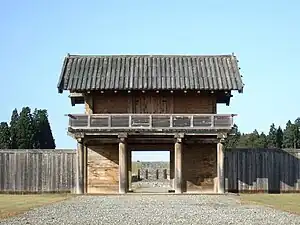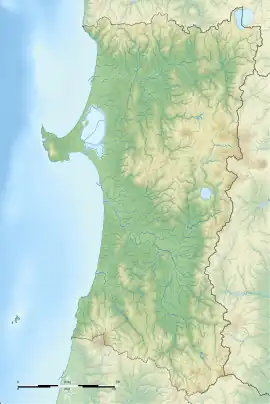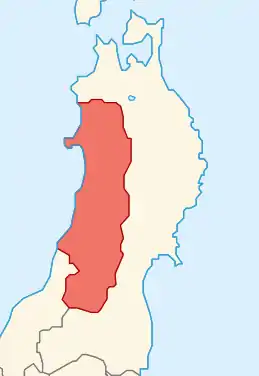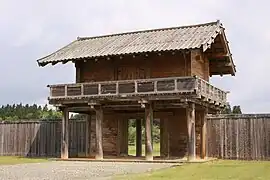Hotta-no-saku
The Hotta-no-saku ruins (払田柵跡, Hotta-no-saku iseki) is an archaeological site containing the ruins of a large-scale Heian period josaku-style fortified settlement located in what is now part of the municipalities of Daisen and Misato in the Tōhoku region of Japan. The site was designated a National Historic Site of Japan in 1931.[1] The site is maintained as an archaeological park with some reconstructed buildings.
| Hotta-no-saku ruins | |
|---|---|
払田柵跡 | |
| Daisen, and Misato, Akita Prefecture, Japan | |
 Reconstructed South Gate of Hotta-no-saku | |
 Hotta-no-saku ruins  Hotta-no-saku ruins  Hotta-no-saku ruins | |
| Coordinates | 39°28′07″N 140°32′50″E |
| Type | josaku-style Japanese castle |
| Site information | |
| Open to the public | yes |
| Condition | ruins |
| Site history | |
| In use | Heian period |
| Demolished | c.801 AD |
Overview
In 1902, farmers discovered the remnants of a large wooden palisade in rice paddies near the border of Misato in Akita Prefecture. Over 200 almost intact fence posts with a diameter of 30 centimeters (12 in), and a height above ground of 3.6 meters (12 ft) were discovered, most of which was subsequently burned for fuel or processed into geta wooden clogs. However, some fragments survived and were later dated by dendrochronology to the year 801 AD. An archaeological survey discovered that this palisade had dimensions of approximately 1,370 meters (4,490 ft) from east-west by 780 meters (2,560 ft) north-south, as was thus larger than Taga Castle, and was actually the largest josaku-style castle in northern Japan. Inscriptions of wooden artifacts found at the site mention Isawa Castle and Shiwa Castle which were created in the early ninth century AD; however, there is no mention of this huge fortification in any historical or literary records.
In the center of the enclosure was the ruins of an inner fortification, containing the pillar foundations for what appears to be an official administrative complex. The site appears to have been abandoned by the middle of the 10th century.
The site has been preserved as an archaeological park with some reconstructed buildings, and is located approximately 20 minutes by bus from the JR East Ōu Main Line Ōmagari Station.
Gallery
 Entry to the site
Entry to the site Remnants of outer palisade
Remnants of outer palisade Reconstructed South Gate
Reconstructed South Gate Foundations of official complex
Foundations of official complex Reconstructed building
Reconstructed building
References
- "払田柵跡" (in Japanese). Agency for Cultural Affairs.